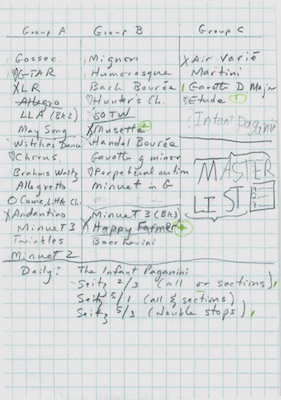Listen in a purposeful, customized way.
Evidence-based Suzuki playlists

As a Suzuki parent, whose own musical training happened to by very traditional, I’m fascinated by how effective listening can be. When kids begin listening at a very early age and continue to listen to their repertoire consistently they develop an almost “sixth sense” about playing.
But after some years of this practice, there’s quite a lot of repertoire to listen to. Although the Suzuki repertoire forms the core of listening, most students go on to learn other literature on the side. And it all adds up. I began to wonder if there might be some way of structuring the listening program to align their listening to their performance ability for each piece. In other words, evidence-based listening.
In this case, the evidence is their ability to perform a particular piece. The hypothesis works like this: if the student isn’t playing a piece up to performance readiness, then maybe part of the problem is just not hearing it enough. Or maybe their only hearing of the piece is their own fuzzy rendition of it. So what would happen if simply gave the student more time listening to pieces that are have lost some of their earlier quality?
Borrowing from the idea of stratifying review practice by classifying pieces into groups based on current performance readiness, the method of evidence-based listening works similarly:
Audition each piece in the repertoire
We began a process of listening to each piece in my daughter’s repertoire dividing the pieces into Group A, Group B, and Group C.
- Group A pieces are those that are ready to perform now. They are polished, with proper bowings, good intonation, and with everything done commensurate with their current technical ability.
- Group B pieces have some irregularities. There might be memory slips, bowing issues, and so on. With a little more work, they could become Group A pieces again.
- Group C pieces need more work. They aren’t performance ready and have major memory difficulties, forgotten repeats and the like. It will take more work on sections to get these into Group B.
It took a few weeks to get this done because there was a festival to prepare for in the middle of it, but there’s not rush. Here’s a copy of the list we came up with:

Group lists
Create iTunes playlists for each of the groups
Essentially we re-mix the Suzuki book CD’s. Instead of arranging the repertoire by book, we’ll now have 3 playlists corresponding to each of the groups we created when she auditioned the pieces.

Group-based playlists in iTunes
Come up with a listening schedule that corresponds to the groups
You’ll want to play the Group C playlist more often than the Group B playlist and the Group B playlist more often than the Group A list. How you do that depends on how much time you have in your family routine. But the point is to identify pieces that need more effort and squeeze in more listening time for those pieces.
Happy listening! Let me know how it goes on our Facebook page





